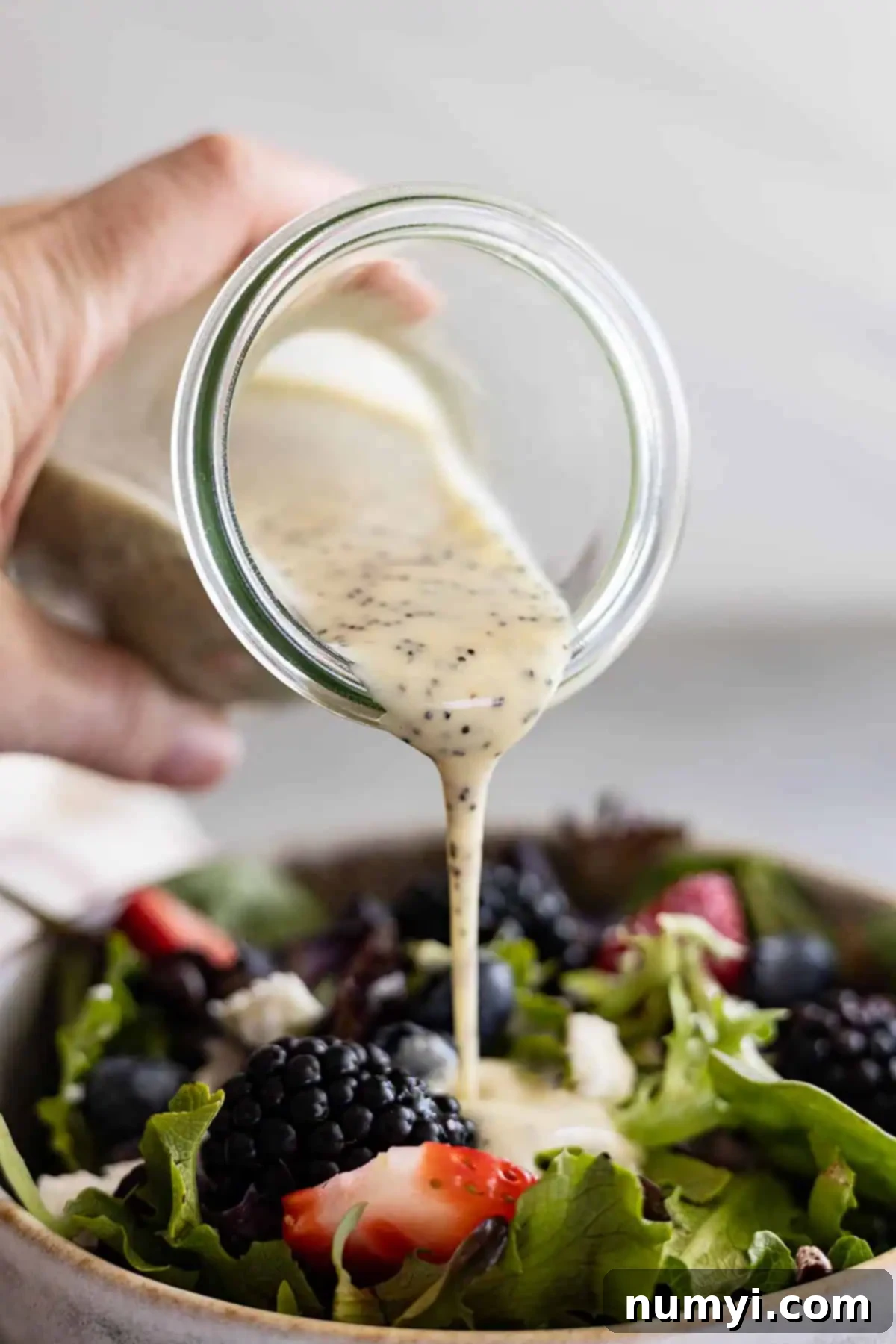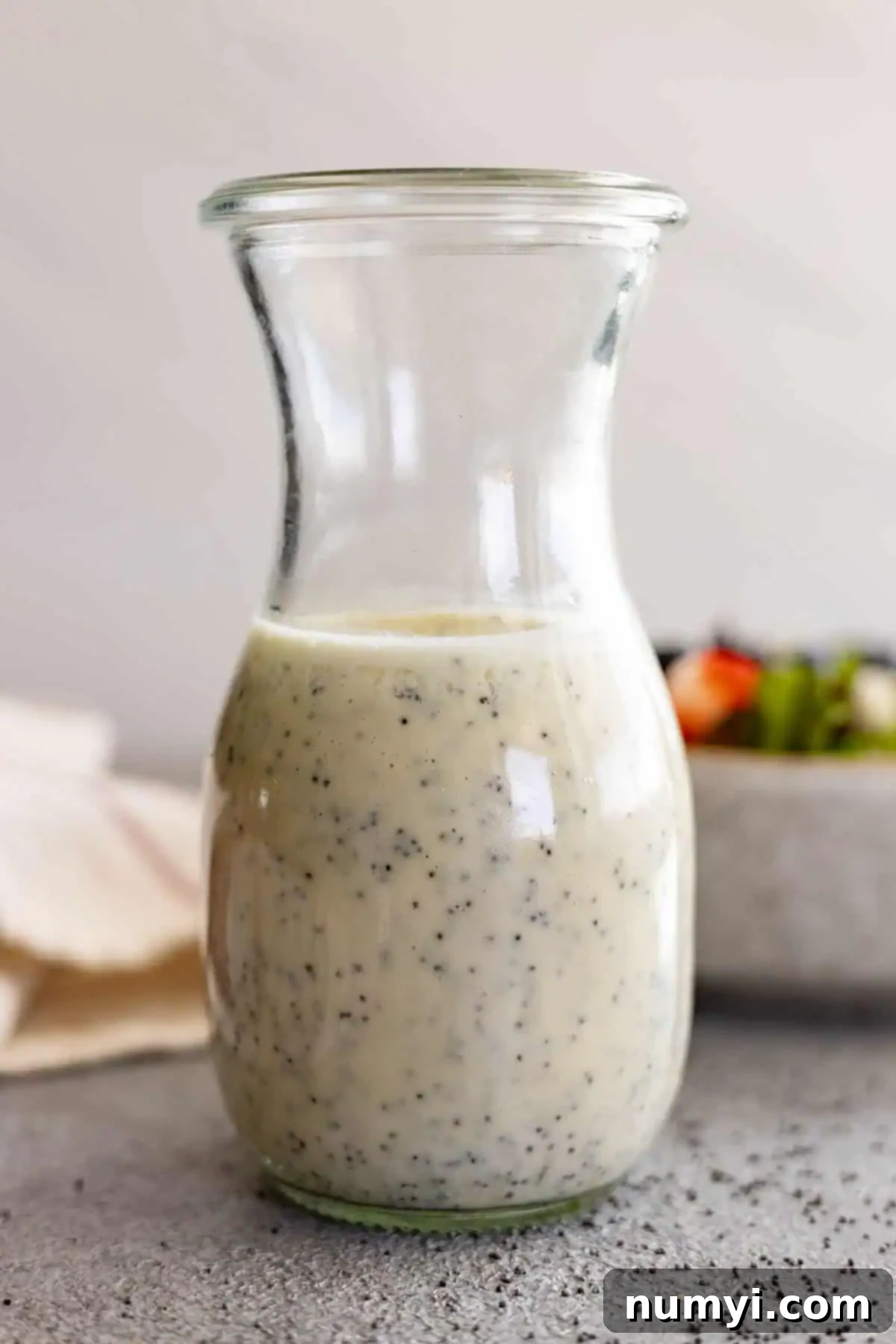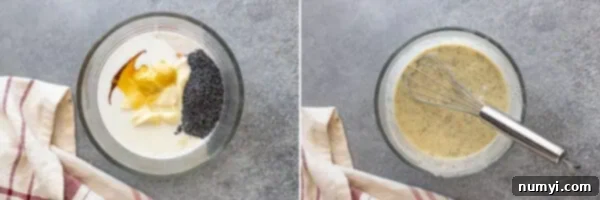Homemade Creamy Poppy Seed Dressing: The Easiest Recipe for Salads & More
Say goodbye to store-bought dressings and hello to this incredible homemade creamy poppy seed dressing! It’s a true kitchen game-changer, always stocked in my fridge because it’s so irresistibly good and incredibly versatile. This recipe proves that making your own dressing is not only straightforward but also immensely rewarding, requiring no special equipment and just a handful of common ingredients. Whether you’re tossing it with fresh fruit, drizzling it over a vibrant green salad, or pairing it with a hearty chicken dish, this dressing adds a delightful balance of sweet, tangy, and creamy notes that elevates any meal.
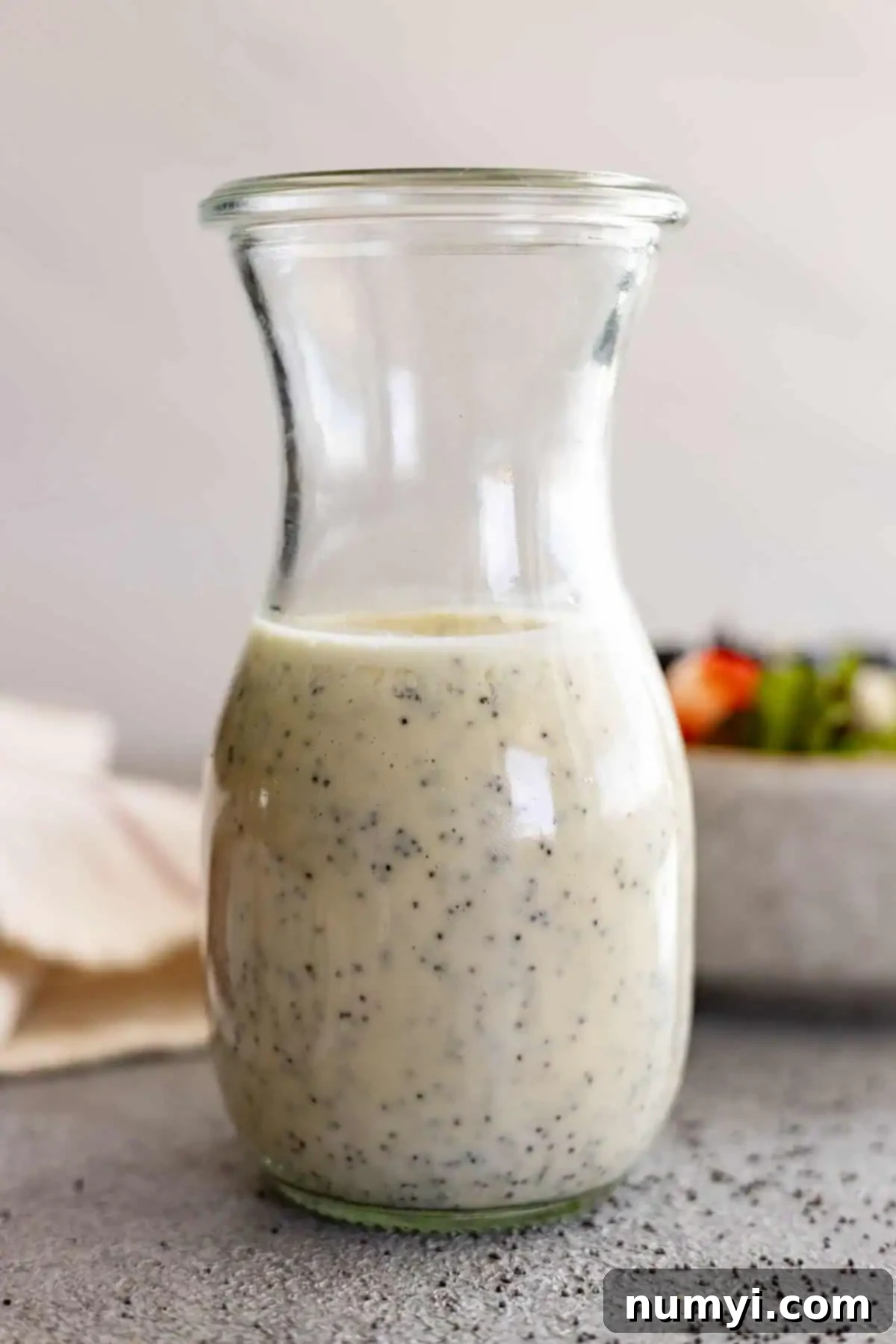
Why Make Your Own Poppy Seed Dressing?
You might be wondering, “Why bother making dressing from scratch when there are so many options at the grocery store?” The answer is simple: taste, freshness, and control. Homemade dressings, especially this creamy poppy seed recipe, offer a depth of flavor that mass-produced versions simply can’t match. You control every ingredient that goes in, meaning you can avoid artificial preservatives, excessive sugars, and unhealthy oils often found in store-bought varieties. Plus, it’s incredibly cost-effective! With just a few pantry staples, you can whip up a batch that’s not only healthier but also bursts with a vibrant, fresh taste that will make your salads sing.
Key Ingredients for the Perfect Creamy Poppy Seed Dressing
This delightful poppy seed dressing relies on a harmonious blend of simple ingredients, each playing a crucial role in creating its signature creamy texture and balanced flavor. Let’s take a closer look at what you’ll need and why these components are essential:
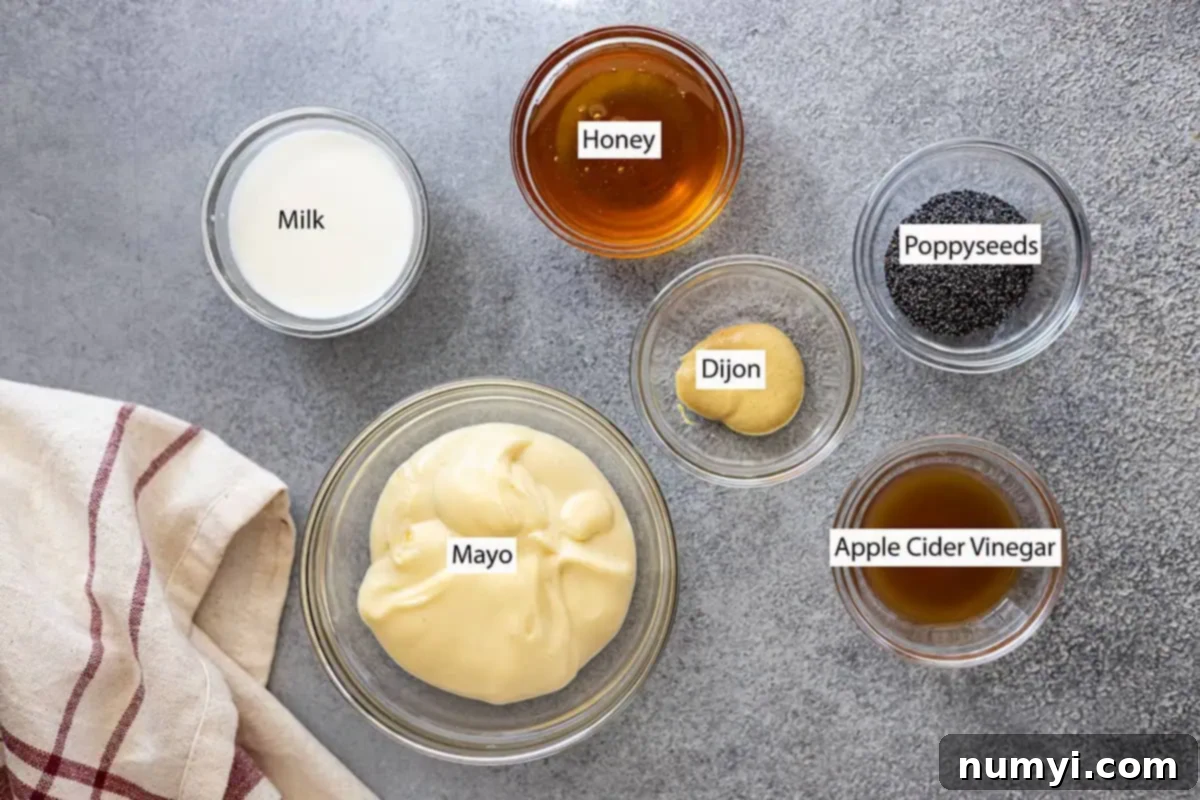
Mayonnaise
The base of our creamy dressing, mayonnaise provides that rich, velvety texture. It acts as an emulsifier, binding all the ingredients together seamlessly.
- Substitution Tip: If you’re looking for a dairy-free option or want to lighten it up, choose a good quality dairy-free mayonnaise or consider making your own. For a tangier profile, Greek yogurt or even sour cream can be excellent substitutes, though they will slightly alter the flavor and consistency. Ensure your chosen mayo is dairy-free if you have dietary restrictions.
Honey
Honey lends a natural sweetness that perfectly balances the tanginess of the vinegar and mustard. It contributes to the overall smooth mouthfeel.
- Substitution Tip: Maple syrup is a fantastic alternative for a slightly different sweet note, especially if you prefer a vegan option. You can also adjust the amount to your personal preference for sweetness.
Milk
A splash of milk helps to thin out the dressing to the perfect pourable consistency while maintaining its creaminess.
- Substitution Tip: For a dairy-free creamy poppy seed dressing, simply swap regular milk for your favorite non-dairy milk, such as almond milk, oat milk, or soy milk. They all work beautifully without compromising the texture.
Apple Cider Vinegar (ACV)
ACV is key for providing that essential bright, acidic tang that cuts through the richness of the mayonnaise and balances the sweetness of the honey.
- Substitution Tip: White wine vinegar or even rice vinegar can be used if you don’t have ACV on hand, offering slightly different acidic notes but still delivering on flavor. Experiment to find your favorite!
Poppy Seeds
Beyond their charming visual appeal, poppy seeds add a subtle, nutty flavor and a delightful textural crunch that makes this dressing truly unique. They are indispensable for a classic poppy seed dressing.
- Usage Tip: Make sure your poppy seeds are fresh for the best flavor and crunch.
Dijon Mustard
Just a teaspoon of Dijon mustard adds a mild, pungent kick and acts as another emulsifier, helping the dressing stay together and preventing separation.
- Substitution Tip: While Dijon is preferred for its smooth texture and balanced flavor, a tiny amount of yellow mustard could work in a pinch, though it might be slightly sharper.
Effortless Preparation: How to Make Creamy Poppy Seed Dressing
Making homemade dressing often seems more complicated than it is. For years, I, like many others, relied solely on store-bought options, believing that homemade versions were too time-consuming or difficult. While I still appreciate some store-bought varieties for specific uses, discovering how truly simple it is to whip up dressings like this creamy poppy seed recipe changed my perspective entirely.
The beauty of this recipe lies in its incredible simplicity and speed. You’re literally just combining ingredients! There are two primary methods you can use, both equally effective and incredibly fast:
Method 1: The Mason Jar Shake
This is my personal favorite, especially when I’m feeling a bit lazy or want to minimize dishwashing. Simply add all your ingredients directly into a mason jar (or any lidded container). Secure the lid tightly and shake vigorously for about 30 seconds to a minute, or until all ingredients are thoroughly combined and the dressing is smooth and emulsified. This method is perfect for quick mixing and easy storage.
Method 2: Bowl and Whisk
If you prefer a more traditional approach, combine all the ingredients in a small mixing bowl. Use a whisk to vigorously combine everything until the dressing is smooth and creamy. Once mixed, simply pour the dressing into a clean jar or bottle for storage. This method allows for a bit more control over the mixing process, ensuring there are no lumps.
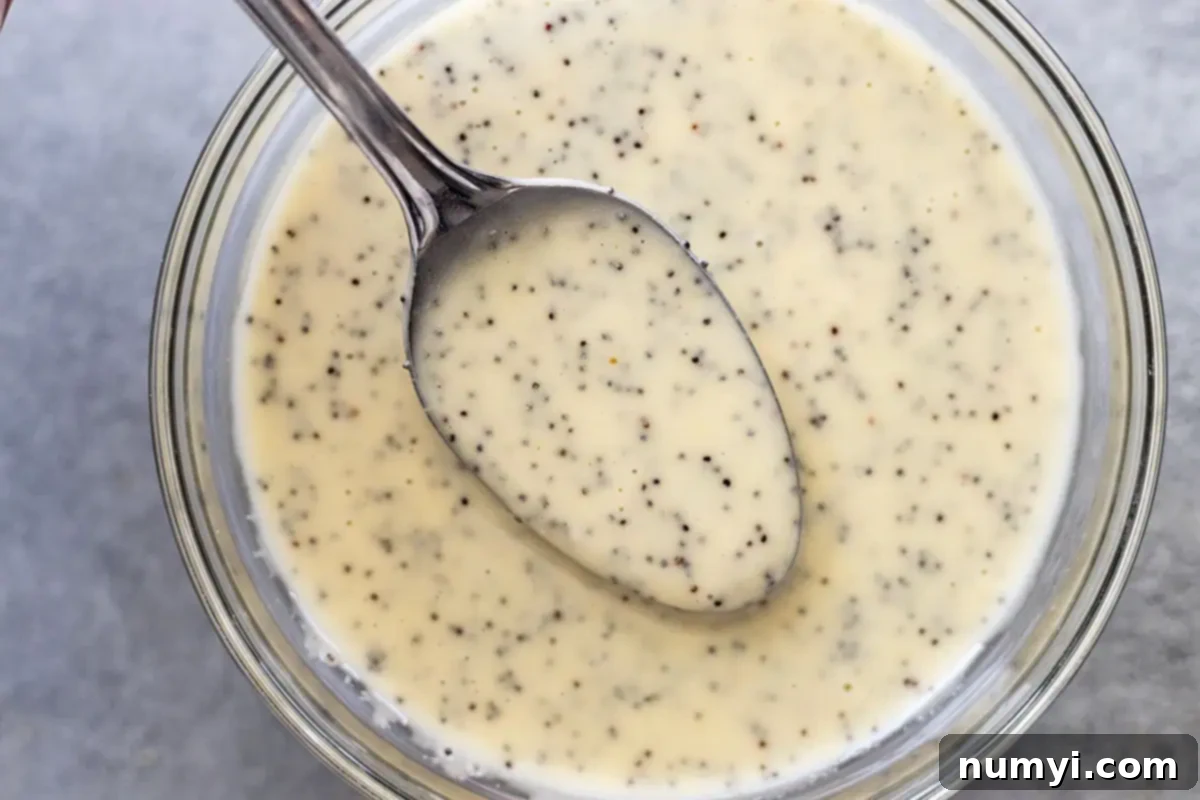
Regardless of the method you choose, the key is to ensure everything is well-combined. The dressing will thicken slightly as it chills, so don’t worry if it seems a little thin right after mixing. A quick whisk or shake before serving will bring it back to perfect consistency.
Variations and Customizations for Your Poppy Seed Dressing
While the classic creamy poppy seed dressing is delicious as is, it’s also wonderfully adaptable! Feel free to get creative and make it truly your own with these exciting variations:
- Dairy-Free Delight: As mentioned, effortlessly swap regular milk for your preferred non-dairy milk (almond, oat, soy) and ensure your mayonnaise is dairy-free (or use a homemade vegan mayo). This makes it suitable for lactose-intolerant individuals and vegans alike.
- Mayo Alternatives: If you’re out of mayonnaise, Greek yogurt provides a fantastic protein boost and a slightly tangier flavor. Sour cream also works well for a rich, creamy, and zesty option. Just be prepared for a bit more tartness.
- Sweetener Swaps: Not a fan of honey? Maple syrup or agave nectar can be used for a different kind of sweetness, and they are excellent vegan choices. You can also adjust the quantity to suit your desired sweetness level.
- Vinegar Adventures: Don’t limit yourself to apple cider vinegar. White wine vinegar offers a crisp, clean acidity, while rice vinegar provides a milder, slightly sweeter tang. For a bolder flavor, try Champagne vinegar.
- Herbaceous Infusions: Elevate the flavor profile by adding finely chopped fresh herbs like chives, parsley, or dill. A pinch of dried garlic powder or onion powder can also add a savory depth.
- Fruity Twists: For an extra burst of freshness, consider blending in a tablespoon or two of fruit puree, like strawberry or raspberry, for a beautiful color and a hint of fruity sweetness, perfect for fruit salads.
- Spice it Up: A tiny pinch of white pepper can add a subtle kick without overwhelming the other flavors.
Beyond Salads: Creative Serving Suggestions
This creamy poppy seed dressing is a superstar not just for green salads but for a myriad of other dishes. Its sweet and tangy profile makes it incredibly versatile:
- Fruit Salads: The classic pairing! Drizzle generously over a mix of berries, melon, grapes, and pineapple for a refreshing side or light dessert.
- Green Salads: From simple mixed greens to more elaborate salads with chicken, nuts, and cheeses, this dressing complements them all. It’s especially good with salads featuring crisp apples, pecans, or cranberries.
- Coleslaw: Use it as a vibrant alternative to traditional coleslaw dressing for a refreshing twist.
- Chicken or Tuna Salad: Stir a tablespoon or two into your chicken or tuna salad for added creaminess and flavor.
- Marinade: Believe it or not, this dressing can act as a tenderizing and flavorful marinade for chicken breasts or pork tenderloin before grilling or baking.
- Sandwich or Wrap Spread: Spread a thin layer on your sandwiches or wraps instead of plain mayonnaise for an extra burst of flavor.
- Grain Bowls: Elevate your quinoa or farro bowls with a drizzle of this dressing for added moisture and taste.
- Vegetable Dip: A delightful dip for raw vegetables like carrots, celery, bell peppers, or cucumber slices.
My Favorite Salad Recipes to Pair With This Dressing:
Looking for inspiration? Here are some of my go-to salad recipes that are absolutely perfect with this creamy poppy seed dressing. While some might suggest different dressings, trust me, this one is a delicious match for these:
- Asian Chicken Salad (Try it for a sweet-savory twist!)
- Tuscan Tuna Salad (Adds a lovely creaminess)
- Turkey Cobb Salad (also great with chicken or ham – the dressing brightens it up!)
- Wilted Spinach Bacon Salad (Offers a beautiful contrast to the warm spinach and salty bacon)
Storage Tips for Optimal Freshness
One of the best things about homemade dressings is that you can make a batch ahead of time and enjoy it throughout the week. Proper storage is key to maintaining its freshness and flavor:
- Refrigeration: Always store your creamy poppy seed dressing in an airtight container, such as a mason jar with a tight-fitting lid, in the refrigerator.
- Shelf Life: When stored correctly, this dressing will keep well for up to 7 days. Beyond that, it might start to lose its fresh flavor or the ingredients could begin to separate more noticeably.
- Before Serving: If the dressing has been sitting for a while, the ingredients might separate slightly. Simply give it a good shake or a quick whisk before serving to recombine everything and restore its creamy texture.
- Freezing: Due to the mayonnaise and milk content, this dressing does not freeze well. The texture will become grainy and separate upon thawing. It’s best enjoyed fresh from the fridge.
Troubleshooting Common Dressing Issues
Even though this recipe is incredibly simple, sometimes things can go slightly awry. Here are a few common issues and how to fix them:
- Dressing is Too Thick: If your dressing is thicker than desired, simply whisk in an additional teaspoon or two of milk (dairy or non-dairy) until it reaches your preferred consistency.
- Dressing is Too Thin: This can happen if you add too much liquid. To thicken it slightly, you can try adding a bit more mayonnaise, or a tiny pinch of cornstarch (dissolved in a small amount of cold water first) and whisk well.
- Too Sweet/Not Sweet Enough: Adjust the honey to your taste. Add a little more for extra sweetness, or a splash more apple cider vinegar or a pinch of salt to balance out excessive sweetness.
- Too Tangy: If the dressing is too tart, a bit more honey or a tiny pinch of sugar can help mellow the acidity.
- Ingredients Separated: This is normal, especially after sitting in the fridge. Just give the jar a good shake or whisk the dressing in a bowl until it’s smooth again before serving.
Frequently Asked Questions (FAQs) About Poppy Seed Dressing
Are poppy seeds safe to eat?
Yes, poppy seeds are perfectly safe to eat in the quantities used in recipes like this. They add flavor and texture without any concern.
Can I make this dressing ahead of time?
Absolutely! This dressing is perfect for meal prep. Make it up to a week in advance and store it in the refrigerator. The flavors often meld and improve over time.
What kind of milk should I use?
Any type of milk works well – whole milk, skim milk, or any non-dairy milk like almond, oat, or soy milk. Choose based on your dietary preferences and what you have on hand.
Is this dressing gluten-free?
Yes, all the ingredients in this recipe (mayonnaise, honey, milk, apple cider vinegar, poppy seeds, Dijon mustard) are typically gluten-free, making this dressing suitable for those avoiding gluten. Always double-check ingredient labels if you have severe sensitivities.
Can I use a food processor or blender?
While not necessary, a food processor or blender can be used for an even smoother consistency, especially if you’re adding fresh herbs or fruit purée. Just be careful not to overmix, which can sometimes thin out the mayo too much.
DID YOU KNOW….
rating and sharing recipes is one of the best ways you can support your favorite food bloggers? If you make this recipe, I would love if you clicked the stars when commenting below to leave a rating and/or sharing a photo on Instagram, Facebook, or Pinterest!
★
★
★
★
Creamy Poppyseed Dressing
8
Malinda Linnebur

Save Recipe
Saved!
5 minutes
5 minutes
Prevent your screen from going dark
Ingredients
-
½
cup (117g)
mayonnaise -
3
tablespoons
honey -
2
tablespoons
milk -
4
teaspoons
apple cider vinegar -
1
tablespoon
poppyseeds -
1
teaspoon
Dijon mustard
Instructions
-
In a small bowl, combine all ingredients and whisk until smooth. Alternatively, add all ingredients to a mason jar, secure the lid, and shake vigorously until well combined.½ cup (117g) mayonnaise,
3 tablespoons honey,
2 tablespoons milk,
4 teaspoons apple cider vinegar,
1 tablespoon poppyseeds,
1 teaspoon Dijon mustard
-
Pour into a clean bottle or jar for storage. Refrigerate for at least 30 minutes before serving to allow flavors to meld and for the dressing to thicken slightly. Enjoy!
Notes
- STORAGE: Store leftovers in an airtight container in the refrigerator for up to 7 days. Give it a good shake before each use.
- NUTRITION: Since different brands of ingredients have different nutritional information, the information shown is just an estimate. This website is not intended as nutritional advice, or a diet or health plan. Readers of this website are ultimately responsible for all decisions pertaining to their health.
Nutrition
Did you make this?
Let me know by sharing a picture and tagging @countryside_cravings on Instagram
